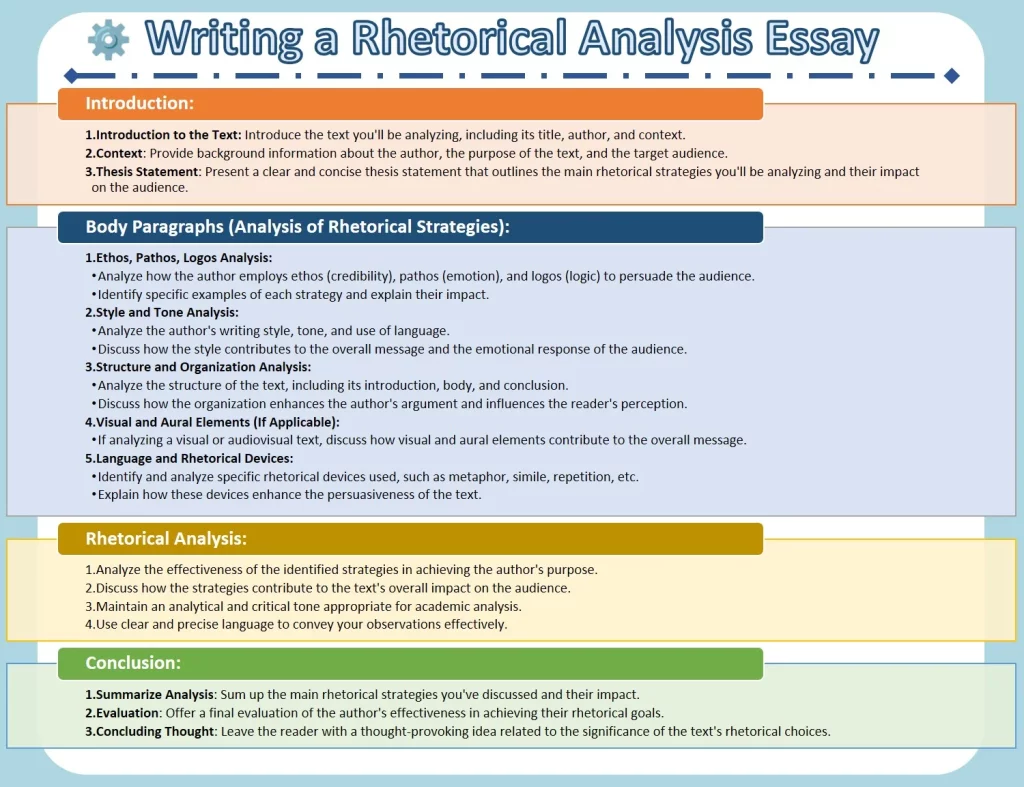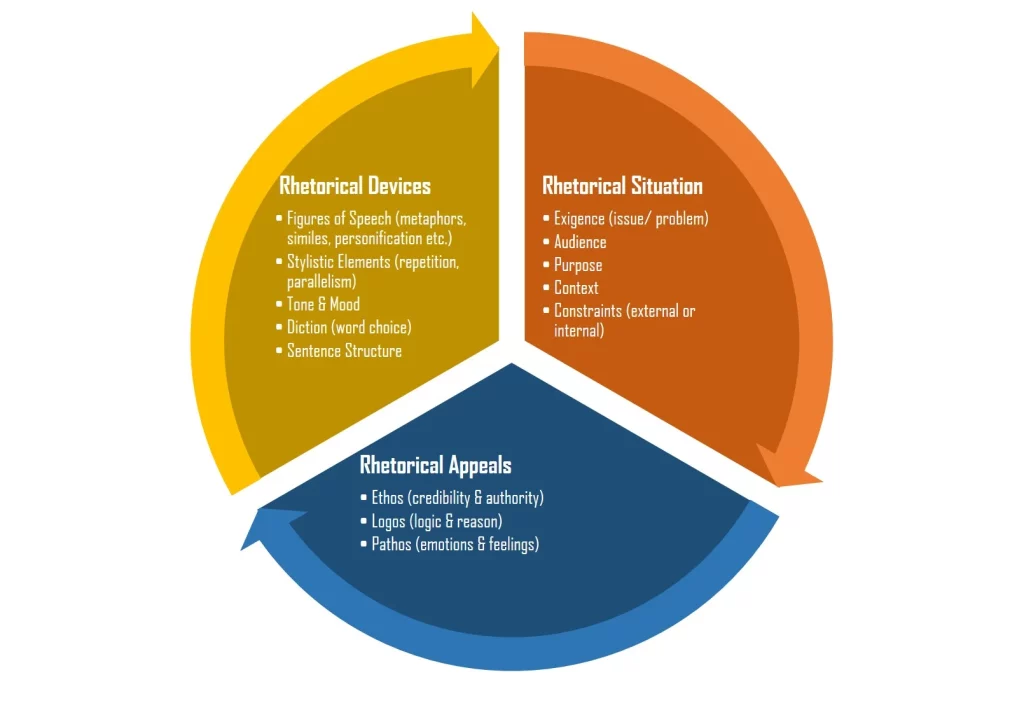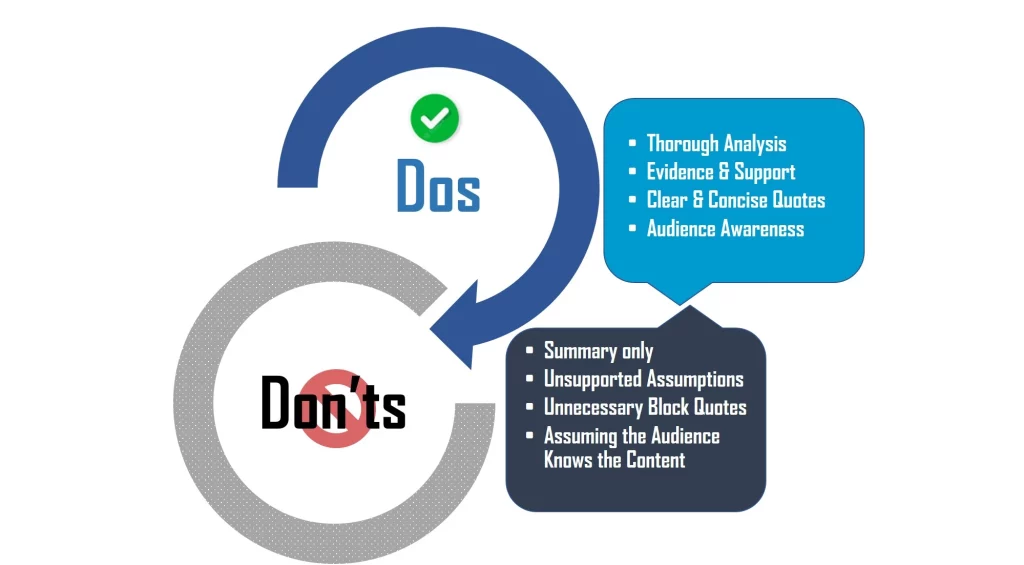
A rhetorical analysis essay is a type of academic writing in which you examine and evaluate the persuasive strategies and techniques used in a piece of communication, such as a speech, essay, advertisement, or any other form of text. The primary goal of a rhetorical analysis essay is to understand how the author or speaker employs rhetoric (the art of persuasion) to convey their message and influence their audience.
Fundamentals

In a rhetorical analysis essay, you often examine three key focus areas: Rhetorical Situation Analysis, Rhetorical Appeals Analysis, and Rhetorical Devices Analysis. Here’s a brief overview of each:
- Rhetorical Situation Analysis:
- Rhetorical Appeals Analysis (Ethos, Pathos, Logos):
Analyzing these three primary rhetorical appeals helps you understand how the author attempts to engage the audience’s beliefs, emotions, and intellect to achieve their persuasive goals.
- Rhetorical Devices Analysis:
In a comprehensive rhetorical analysis, you typically address all three of these focus areas to provide a thorough examination of how the text’s rhetorical choices work together to persuade the audience. Each area provides a unique lens through which to assess the author’s persuasive strategies and the overall effectiveness of the communication.
Key Distinguishing Characteristics
- Text or Artifact: You begin by selecting a specific text or artifact to analyze. This could be a famous speech (e.g., Martin Luther King Jr.’s “I Have a Dream” speech), a political advertisement, a literary work, or any other piece of communication that contains persuasive elements
- Analysis – Focus on Persuasion and Rhetoric: A rhetorical analysis essay is primarily concerned with examining the persuasive techniques and rhetorical strategies used in a piece of communication. The central goal is to understand how the author or speaker tries to persuade the audience and the methods they employ to achieve that persuasion.
- Objective and Critical Tone: A rhetorical analysis essay maintains an objective and critical tone. It does not express personal opinions or judgments about the subject matter but focuses on evaluating the effectiveness of the rhetorical strategies employed by the author or speaker.
- Use of Evidence: To support the analysis, the essay relies on evidence from the text being analyzed. This may involve quoting or paraphrasing specific passages, lines, or examples that illustrate the rhetorical strategies discussed.
- Thesis Statement: The essay begins with a clear and concise thesis statement that outlines the rhetorical strategies to be analyzed and the overall effectiveness of the text’s persuasion.
- Structured Organization: Rhetorical analysis essays follow a structured organization, typically including an introduction, body paragraphs focusing on specific rhetorical elements, and a conclusion. Each body paragraph may be dedicated to analyzing a single rhetorical element or strategy.
- Audience and Purpose Consideration: The essay considers the intended audience of the text and the author’s purpose in persuading that audience. Understanding the context in which the communication was created is essential to effective analysis.
- Evaluation and Interpretation: While the primary focus is on analysis, a rhetorical analysis essay also involves evaluating the impact and success of the rhetorical strategies applied. It interprets how well these strategies serve the author’s purpose and whether they effectively engage the audience.
- Broader Context: In the conclusion or final thoughts section, discuss the relevance of the text in its historical, cultural, or social context. Consider the lasting influence or significance of the communication.
In summary, a rhetorical analysis essay distinguishes itself by its emphasis on dissecting persuasive techniques and rhetorical elements in a specific piece of communication. It maintains an objective and critical tone and relies on evidence from the text for analysis. Understanding the author’s purpose, the intended audience, and the context in which the communication occurs is crucial to a thorough analysis.
General Outline
- Introduction:
- Body Paragraphs (usually 3-5 paragraphs, depending on the length of your essay):
- Explanatory Paragraphs (for each rhetorical element):
- Evaluative Paragraphs:
- Conclusion:
- Final Thoughts (optional):
- Works Cited or References (if required):
Remember to use a clear and organized structure in your essay, provide ample evidence and analysis, and maintain a critical and objective tone throughout. A well-written rhetorical analysis essay demonstrates your ability to deconstruct persuasive communication and evaluate the strategies used by the author or speaker to convey their message effectively.
Approaches & Sample Essays
Rhetorical Summary:
Sample Rhetorical Summary & Evaluation Essay: Narrative of the Life of Frederick Douglass
Rhetorical Criticism:
Sample Rhetorical Criticism Essay: MLK’s “I Have a Dream.”
Rhetorical Self:
Rhetorical Précis:
Rhetorical Response:
Sample Rhetorical Response Essay: Amy Tan’s “Mother Tongue.”
Comparative Rhetorical Analysis:
Sample Comparative Rhetorical Analysis Essay: “The Great Gatsby” vs. “Beloved.”
These different approaches to rhetorical analysis essays allow for various levels of engagement with texts, from providing objective summaries to offering critical assessments and personal responses. The choice of approach depends on the goals of the analysis and the context in which it is conducted.
Types
- Textual Rhetorical Analysis:
- Visual Rhetorical Analysis:
- Multimodal Rhetorical Analysis:
- Film Rhetorical Analysis:
- Political Rhetorical Analysis:
- Literary Rhetorical Analysis:
- Historical Rhetorical Analysis:
- Scientific Rhetorical Analysis:
- Contemporary Rhetorical Analysis:
The choice of the rhetorical analysis essay type depends on the text or subject you are analyzing and the specific goals of your analysis. Regardless of the type, all rhetorical analysis essays share the common goal of dissecting persuasive techniques and rhetorical strategies to gain a deeper understanding of how communication influences its audience.
Dos and Don’ts

- Analyze, Not Summarize!
- Audience Awareness, Not Assumption!
- Organization and Structure, Not Haphazard!
- Evidence and Support, No Unsupported Assertions!
- Clear Thesis, Not Broad or Irrelevant!
- Originality and Attribution, Don’t Plagiarize!
- Clear and Concise, Avoid Block Direct Quotes!
Following these key writing essentials will help you produce clear, effective, and well-received written work while avoiding common pitfalls in writing.
Frequently Asked Questions (F.A.Qs)
-
Does a rhetorical analysis essay differ from a rhetorical argument essay?
Yes, a rhetorical analysis essay and a rhetorical argument essay serve different purposes. A rhetorical analysis essay focuses on examining and explaining the rhetorical strategies and techniques used in a text or speech, while a rhetorical argument essay aims to persuade or argue a specific point using rhetorical devices. The former is more about analysis, while the latter is more about making an argument.
-
How do I select a text or speech for analysis in a rhetorical analysis essay?
Choose a text or speech that is rich in rhetorical elements, such as persuasive language, stylistic devices, and strong arguments. It should also be relevant to your purpose or assignment.
-
How do I identify and analyze rhetorical devices and persuasive techniques in a text?
Look for elements such as ethos (credibility), pathos (emotional appeal), and logos (logic) in the text. Analyze the author’s use of tone, diction, figurative language, and any other persuasive strategies. Consider the context and audience impact.
-
Should I use first-person or third-person perspective in a rhetorical analysis essay?
Generally, it’s advisable to use a third-person perspective in academic writing, including rhetorical analysis essays. This maintains a more objective and formal tone.
-
What role does audience analysis play in a successful rhetorical analysis?
Understanding the intended audience is crucial because it helps you evaluate how effectively the author’s rhetoric addresses that audience. Consider the audience’s values, beliefs, and potential reactions to the rhetorical strategies.
-
Is it necessary to include a thesis statement in a rhetorical analysis essay?
Yes, a thesis statement is essential in a rhetorical analysis essay. It should provide a clear and arguable claim about the effectiveness of the author’s rhetorical strategies, guiding the analysis that follows.
-
How do I draw conclusions and make inferences from my analysis?
Your conclusions should summarize your key findings regarding the author’s use of rhetoric and how it influences the audience. Make inferences based on the evidence you’ve gathered.
-
What are the key steps in revising and editing a rhetorical analysis essay to ensure it is well-structured and persuasive?
Revise for clarity and coherence in your analysis. Ensure each paragraph focuses on a specific aspect of the rhetorical strategies. Edit for grammar, spelling, and punctuation errors. Seek feedback from peers or a writing tutor to improve structure and argumentation.
